Geography, Mapping, Ecology & Environment
Kopi Luwak:
-
- A recent scientific study by researchers of the Central University of Kerala has revealed that civet processed robusta coffee, popularly known Kopi Luwak, shows distinct difference in its fatty acid methyl esters and total fat content when compared to naturally harvested robusta beans.
- The unique sensory, nutritional and aromatic qualities of the civet coffee, one of the world’s exotic brews.
- Civet coffee, primarily produced from the excreta of the Asian palm civet (Paradoxurus hermaphroditus), is made when the animal consumes ripe coffee cherries.
- The pulp is digested while the beans, subjected to natural fermentation inside the gut, are excreted intact and later collected for processing.
- Civet-processed beans were larger and contained higher fat contents than manually collected ones.
- The researchers concluded that the civet’s digestive and enzymatic process naturally ferment the bean, subtly altering their chemical structures and enriching their sensory profile.
(TH)
India’s forest-status:
-
- India has moved up to 9th globally in total forest area.
- India retains the 3rd position globally in net annual forest area gain.
- India ranks 5th among global carbon sinks, with its forests removing around 150 Mt CO₂/year during 2021-25.
- Global total forest area is ~4.14 billion hectares (~32% of world land area).
- The annual rate of net forest loss worldwide fell from ~10.7 million ha (1990-2000) to ~4.12 million ha (2015-25).
(PIB)
Defence & Security
Indian Coast Guard launches two Fast Patrol Vessels: ICGS Ajit and ICGS Aparajit:
-
- At Goa Shipyard on 24 Oct 2025.
- Indigenous Build: Both vessels designed and built entirely in India, showcasing domestic shipbuilding capabilities.
- These vessels are the seventh and eighth in a series of eight indigenously built FPVs being constructed for the ICG.
- Specifications: 52m length, 320 tonnes, equipped with Controllable Pitch Propellers (CPP) for superior manoeuvrability.
- Roles: Multi-mission capabilities – coastal patrol, anti-smuggling, anti-piracy, fisheries protection, and search & rescue.
- Significance: Enhances ICG’s operational readiness, maritime security, and supports national self-reliance and MSME ecosystem.
(PIB)
‘Mahe’, the first Anti-Submarine Warfare Shallow Water Crafts (ASW SWC):
-
- Delivery to Indian Navy: ‘Mahe’, the first of eight ASW SWCs being constructed by CSL, was delivered to the Indian Navy on October 23, 2025.
- Indigenous Design and Build: The vessel was indigenously designed and constructed by CSL, reflecting India’s growing self-reliance in naval shipbuilding.
- Specifications: ‘Mahe’ is approximately 78 meters in length, with a displacement of around 1,100 tons. It is equipped with torpedoes, Multifunctional Anti-Submarine Rockets, and advanced radars and sonars.
- Capabilities: The vessel is designed for underwater surveillance, Low Intensity Maritime Operations (LIMO), Anti-Submarine Warfare (ASW) operations in coastal waters, and has advanced mine-laying capabilities.
- Contribution to Maritime Security: The induction of ASW SWCs will significantly augment the Indian Navy’s ASW capability, enhancing maritime security in the littorals.
- Indigenous Content: ‘Mahe’ boasts over 80% indigenous content, marking a significant milestone in India’s vision of ‘Aatmanirbhar Bharat’.
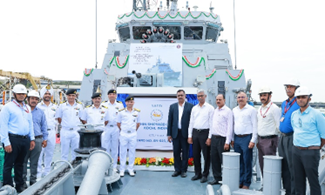
(PIB)
INS Vikrant:
-
- It is India’s first indigenously built aircraft carrier, commissioned on 2 September 2022.
- It has about 76% indigenous content (including ~30,000 tonnes of steel supplied by Steel Authority of India Limited) and involved over 550 OEMs and 100 MSMEs.
- It has demonstrated humanitarian assistance/disaster relief (HADR) capabilities: in March 2025 it evacuated injured crew from a merchant vessel about 230 nautical miles off Goa.
- It symbolises India’s push for defence indigenisation, maritime self-reliance and capability in the Indian Ocean Region.
- Capabilities and Specifications:
- The carrier is 262.5 metres long and 61.6 metres wide, with a displacement of approximately 45,000 tonnes.
- It is powered by four gas turbines that together generate about 88 megawatts of power.
- It can achieve a maximum designed speed of 28 knots.
- The ship accommodates around 1,600 personnel, including women officers and sailors, and contains approximately 2,200 compartments.
- It operates on the Short Take-Off But Arrested Recovery (STOBAR) system, which allows aircraft to take off using a ski-jump and land with the help of arrester wires.
- The carrier can host up to 30 aircraft, including MiG 29K fighter jets, MiG 29 KUB, Chetak, Kamov 31, MH 60R helicopters and Advanced Light Helicopters (ALH).
- The ship generates enough electricity to power nearly 5,000 households, with internal wiring long enough to stretch from Kochi to Kashi.
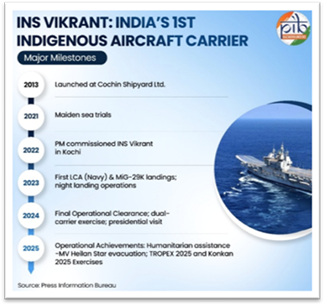
(PIB)
History, Art & Culture
Rani Chennamma:
-
- Context: The year-long nationwide commemoration of the 200thanniversary of Rani Chennamma’s legendary victory at Kittur concluded.
- A special commemorative coin of ₹200 denomination was released to honour her.
- It reflected on how Rani Chennamma’s defiance laid the ethical foundation for India’s freedom struggle, inspiring generations of women to lead with resolve and empathy.
- Born on 23 October 1778 at Kakati in Belagavi district, Karnataka.
- Became the Queen of Kittur after marrying Raja Mallasarja and later ruled after his death in 1824.
- Adopted Shivalingappa as her heir, which the British East India Company rejected under the Doctrine of Lapse policy.
- Led an armed rebellion against British annexation attempts in 1824, one of the first female-led revolts against British rule in India.
- Initially defeated British troops, killing collector St. John Thackeray, but was later captured and imprisoned in Bailhongal Fort.
- Died in captivity on 21 February 1829 but became a symbol of courage and resistance against British imperialism.
- Remembered in Karnataka as a national heroine; honoured by through annual Kittur Utsava celebrations.
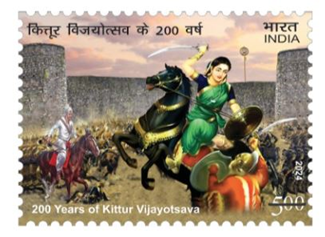
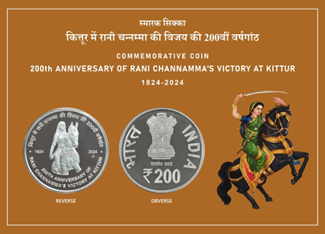
(PIB)
Government Schemes
PM SVANidhi Scheme:
-
- Context: Union Minister of Housing & Urban Affairs chaired a review meeting with representatives of 33 States/UTs, the Ministry of Housing & Urban Affairs (MoHUA), the Department of Financial Services (DFS) and major banks/SLBCs.
- The review followed recent Cabinet approval for the restructuring and extension of the scheme.
- Key directive: States, UTs and banks must accelerate awareness generation, identify eligible street vendors, and expedite loan sanctions and disbursements under the scheme.
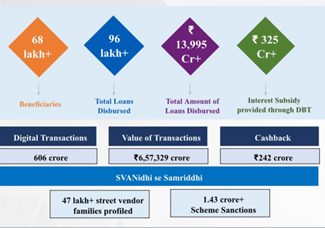
-
- Launched on 1 June 2020 by the Ministry of Housing and Urban Affairs to support street vendors affected by the COVID-19 pandemic.
- Provides collateral-free working capital loans, starting from ₹10,000; subsequent cycles allow ₹20,000 and ₹50,000 loans for timely repayers.
- Offers a 7% interest subsidy per annum on timely or early repayment of the loan, credited directly to beneficiaries’ bank accounts.
- Promotes digital payments through cashback incentives of up to ₹1,200–₹1,600 per year for vendors using UPI or QR code transactions.
- Integrates street vendors into the formal financial system and encourages financial inclusion and credit history building.
- Implementation partners: Ministry of Housing and Urban Affairs (MoHUA) and SIDBI; local bodies identify beneficiaries.
(PIB)
Gyan Bharatam Mission:
-
- It is a flagship initiative of the Ministry of Culture for identifying, documenting, conserving, digitising, preserving, and promoting India’s vast manuscript heritage.
- It was announced during the Union Budget this year (2025).
- The mission’s mandate is to preserve and establish a dedicated digital platform, known as the National Digital Repository (NDR), to share India’s manuscript heritage worldwide.
(TH)
Terms in news
Genna:
-
- The Nagas in Manipur have declared a ‘Genna’ in honour of National Socialist Council of Nagalim (NSCN) leader Thuingaleng Muivah ahead of his visit to the State’s Senapati on October 29.
- Genna, in Naga culture and traditions, refers to restrictions to ensure maximum participation when a national holiday or an important day for the community is observed.
(TH)
Captions and Quotations
Security:
-
- “The Indian Navy has transformed from a ‘Buyer’s Navy’ to a ‘Builder’s Navy’, with significant number of warships under construction in Indian shipyards.”
(TH)
Important data/facts
Geography & Environment
Soyabean production:
-
- Madhya Pradesh is India’s largest soybean producer.
(TH)
Miscellaneous
Ministry of Women and Child Development announces New Helpline Number for POSHAN and PMMVY:
-
- New helpline number 1515 will be live from 1st November 2025, replacing the existing number 14408.
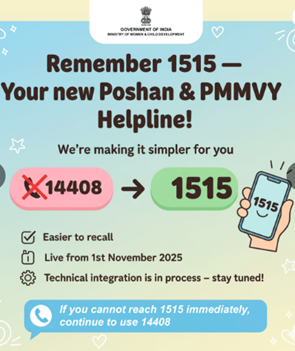
(PIB)
PRACTICE MCQ’S
Q1. Consider the following statements:
1. Rani Chennamma of Kittur led one of the earliest armed revolts against British rule in 1824, opposing the Doctrine of Lapse.
2. A ₹200 commemorative coin was issued in her honour on the 200th anniversary of her victory at Kittur.
Which of the statements given above is/are correct?
a) 1 only
b) 2 only
c) Both 1 and 2
d) Neither 1 nor 2
Answer: C
Explanation:
Rani Chennamma, the Queen of Kittur (Karnataka), resisted British annexation attempts in 1824 after they rejected her adopted heir under the Doctrine of Lapse. She became one of India’s earliest female freedom fighters. In 2025, the Government commemorated 200 years of her victory by releasing a ₹200 coin in her honour.
Q2. Consider the following statements:
1. The Indian Coast Guard recently launched two indigenously built Fast Patrol Vessels, ICGS Ajit and ICGS Aparajit, at Goa Shipyard Limited.
2. These vessels are equipped with Controllable Pitch Propellers (CPP), a first in their class in India, enhancing manoeuvrability and propulsion efficiency.
Which of the statements given above is/are correct?
a) 1 only
b) 2 only
c) Both 1 and 2
d) Neither 1 nor 2
Answer: C
Explanation:
ICGS Ajit and ICGS Aparajit are the 7th and 8th Fast Patrol Vessels launched by the Indian Coast Guard at Goa Shipyard Limited on 24 October 2025.
They are indigenously designed and built, featuring Controllable Pitch Propellers, the first of their kind in this class, to enhance manoeuvrability, contributing to India’s maritime security and self-reliance.
Q3. Consider the following statements regarding Kopi Luwak coffee:
1. It is produced from coffee beans that have passed through the digestive tract of the Asian palm civet.
2. The civet’s digestive enzymes naturally ferment the beans, altering their chemical and sensory profile.
3. Civet-processed beans are smaller and contain lower fat content than manually collected ones.
How many of the statements given above is/are correct?
a) Only one
b) Only two
c) All three
d) None
Answer: B
Explanation:
Statements 1 and 2 are correct: Kopi Luwak is made from civet-excreted coffee beans that undergo natural fermentation inside the animal’s gut, enhancing aroma and taste.
Statement 3 is incorrect: Civet-processed beans are larger and have higher fat content, not smaller or lower.
Q4. Consider the following statements regarding INS Vikrant:
1. It is India’s first indigenously built aircraft carrier, commissioned in 2022.
2. The ship has over 75% indigenous content and can operate around 30 aircraft.
3. It was constructed by Mazagon Dock Shipbuilders Limited, Mumbai.
How many of the statements given above is/are correct?
a) Only one
b) Only two
c) All three
d) None
Answer: B
Explanation:
Statements 1 and 2 are correct: INS Vikrant is India’s first indigenously built aircraft carrier, commissioned in September 2022, with about 76% indigenous content and capacity to operate up to 30 aircraft.
Statement 3 is incorrect: it was constructed by Cochin Shipyard Limited (CSL), Kochi, not Mazagon Dock Shipbuilders.
Q5. With reference to the PM Street Vendor’s AtmaNirbhar Nidhi (PM SVANidhi) Scheme, which one of the following statements is incorrect?
a) It provides collateral-free working capital loans to street vendors in urban areas.
b) The scheme is implemented by the Ministry of Housing and Urban Affairs.
c) It offers incentives for digital transactions and timely repayment.
d) The loans provided under the scheme are completely interest-free.
Answer: D
Explanation:
PM SVANidhi loans are collateral-free but not interest-free; beneficiaries must repay them, and interest subsidies are given for timely repayment.
Q6. Consider the following statements regarding the Gyan Bharatam Mission:
1. The mission aims to preserve, digitize, and disseminate India’s manuscript heritage and revive civilizational knowledge traditions.
2. It plans to use AI, OCR, and blockchain technologies for transcription, smart access, and provenance tracking of manuscripts.
3. “Pandulipi Mitras” are a network of trained volunteers for manuscript conservation and public engagement.
4. The mission is exclusively focused on establishing physical archives without any digital or technological integration.
Which of the statements given above are correct?
a) 1 and 2 only
b) 1, 2, and 3 only
c) 2, 3, and 4 only
d) All four
Answer: B
Explanation:
Statements 1, 2, and 3 are correct: the mission’s vision is to preserve, digitize, and disseminate manuscripts, integrating AI, OCR, and blockchain technologies and leveraging volunteers (“Pandulipi Mitras”) for conservation and outreach.
Statement 4 is incorrect because the mission is technology-driven and not limited to physical archives — it emphasizes digital platforms, cloud storage, and integration with national and international repositories.
Spread the Word
